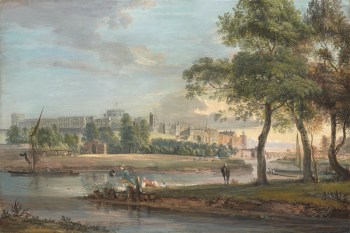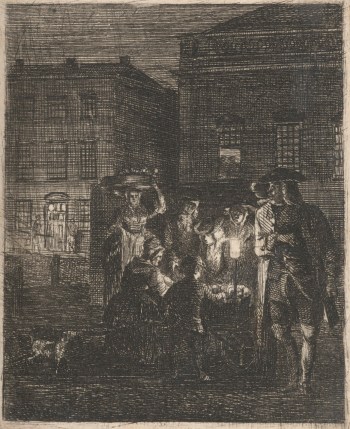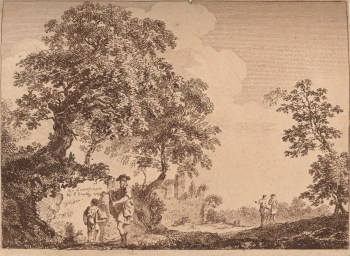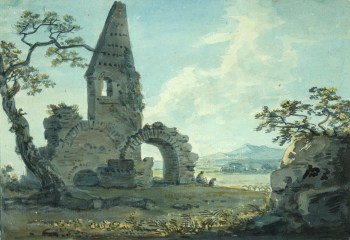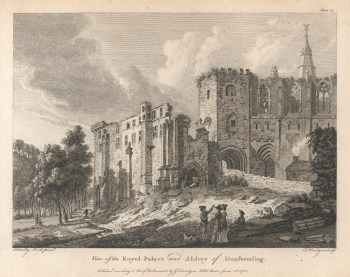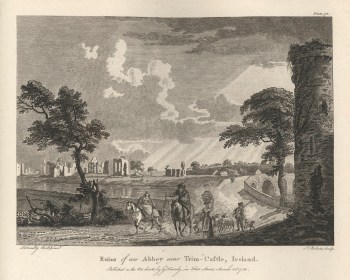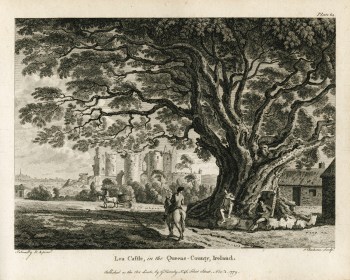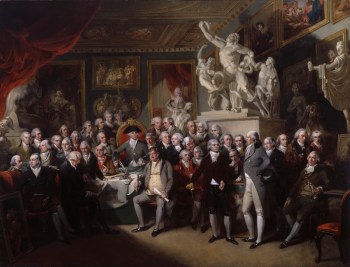Paul Sandby RA (1730/31 - 1809)
RA Collection: People and Organisations
A Founder Member of the Royal Academy, Paul Sandby is remembered as ‘the father of English watercolour’ and also pioneered the new printing technique of aquatint.
Sandby was born in Nottingham in 1731, and is thought to have learnt his early skills as a draughtsman from his brother Thomas, who became a prominent architect. This equipped him to work as draughtsman to the military survey of the Scottish highlands set up in the wake of the 1745 Jacobite uprising. Over a five year period Sandby made many landscape watercolours in Scotland, before moving to London.
He continued to paint landscapes in gouache and watercolour, while also demonstrating a skill for satire in the set of etchings he made satirising William Hogarth (1753–4). Sandby also worked as a drawing master, instructing several of his patrons and holding the post of chief drawing master at the Royal Military Academy, Woolwich for many years. In this way, he influenced subsequent developments of the British watercolour school through his teaching as well as through exhibiting his works.
Sandby helped to further popularise watercolour through the printing technique of aquatint, which he named and promoted. Aquatint involves creating areas of tonal shading rather than line (as in an etching or engraving), and so is particularly effective for reproducing watercolours. Making over a hundred prints in the medium, Sandby also continued to make engravings.
Sandby exhibited at the Society of Artists until 1768, when he defected to become a Founder Member of the new Royal Academy. He showed almost annually at the institution from its first exhibition in 1769 until his death in 1809. In his difficult final years Sandby was granted an annual pension by the Academy to support him and his family.
RA Collections Decolonial Research Project - Extended Biography
Sandby was a subscriber to the second edition of Ottobah Cugoano’s Thoughts and Sentiments on the Evil of Slavery (1791), an anti-slavery tract (see Notes, 1).
Sandby’s elder son, Paul, was an officer in the British army and died in Barbados in 1793.
For more information on this research project, please see https://www.royalacademy.org.uk/article/ra-collections-decolonial-research
Notes 1. Cugoano, Ottobah. Thoughts and sentiments on the evil or slavery; Or, the nature of servitude as admitted by the law of God, compared to the modern slavery of the Africans in the West-Indies; in an answer to the advocates for slavery and oppression. Addressed to the sons of Africa, by a native (London, 1791); https://link.gale.com/apps/doc/CB0126566527/ECCO?u=lonlib&sid=bookmark-ECCO&xid=f994b30d&pg=1 (accessed 1 March 2022).
Relevant ODNB entries
Herrmann, Luke. “Sandby, Paul (bap. 1731, d. 1809), painter and engraver.” Oxford Dictionary of National Biography. 23 Sep. 2004; Accessed 1 Mar. 2022. https://www-oxforddnb-com.lonlib.idm.oclc.org/view/10.1093/ref:odnb/9780198614128.001.0001/odnb-9780198614128-e-24613
Profile
Foundation Member
Born: 1730/31 in Nottingham, Nottinghamshire, England, United Kingdom
Died: 8 November 1809
Nationality: British
Elected RA: 10 December 1768
Gender: Male
Preferred media: Painting, Watercolour, Printmaking, Engraving, and Aquatint engraving
Works by Paul Sandby in the RA Collection
8 results
-
![Paul Sandby RA, View of Windsor Castle from the banks of the River Thames]()
Paul Sandby RA
View of Windsor Castle from the banks of the River Thames, 1794
Gouache and watercolour on laid paper
-
![Paul Sandby RA, Market Scene at Night]()
Paul Sandby RA
Market Scene at Night, c. 1750-55
Etching
-
![Paul Sandby RA, Landscape]()
Paul Sandby RA
Landscape, 1758
Etching
-
![Paul Sandby RA, Wenlock Abbey, Shropshire, The South Transept and Converted Prior's Lodge Seen from the North Transept]()
Paul Sandby RA
Wenlock Abbey, Shropshire, The South Transept and Converted Prior's Lodge Seen from the North Transept, by 1779
Pencil and watercolour on laid paper
-
![Paul Sandby RA, Roche Abbey, Yorkshire]()
Paul Sandby RA
Roche Abbey, Yorkshire, probably 1770s
Pencil and watercolour on laid paper
-
![Paul Sandby RA, A thatched cottage]()
Paul Sandby RA
A thatched cottage
Pencil on thick laid paper
-
![Paul Sandby RA, Ruins in a landscape]()
Paul Sandby RA
Ruins in a landscape
Pencil and watercolour on laid paper (card)
-
![Paul Sandby RA, A wooded landscape with figures and cattle]()
Paul Sandby RA
A wooded landscape with figures and cattle, late 1790s
Pen and ink and grey wash on laid paper
Works after Paul Sandby in the RA Collection
67 results
-
![Paul Sandby RA, A Perspective View of the Royal Academy in the Strand ...]()
After Paul Sandby RA
A Perspective View of the Royal Academy in the Strand ..., 1 January 1779
Line engraving
-
![Paul Sandby RA, The virtuosi's museum :]()
After Paul Sandby RA
The Tinnihinch Road, with a view of Bray-Town, Co. Wicklow, 1 January 1781
Etching with engraving
-
![Paul Sandby RA, The virtuosi's museum :]()
After Paul Sandby RA
Fall of the Polufuca on the River Liffey, 1 January 1781
Etching with engraving
-
![Paul Sandby RA, The virtuosi's museum :]()
After Paul Sandby RA
Mayfield Abbey, in Sussex, 1 January 1781
Etching with engraving
-
![Paul Sandby RA, The virtuosi's museum :]()
After Paul Sandby RA
South View of Sterling Castle, 1 December 1779
Etching with engraving
-
![Paul Sandby RA, The virtuosi's museum :]()
After Paul Sandby RA
Glasgow Cathedral, 1 December 1780
Etching with engraving
-
![Paul Sandby RA, The virtuosi's museum :]()
After Paul Sandby RA
View of the late Encampment in St. James's Park, August 1780., 1 December 1780
Etching with engraving
-
![Paul Sandby RA, The virtuosi's museum :]()
After Paul Sandby RA
Newstead, in Nottinghamshire, the Seat of Lord Byron, 1 November 1780
Etching with engraving
-
![Paul Sandby RA, The virtuosi's museum :]()
After Paul Sandby RA
View of the Encampment in the Museum Garden, 1 October 1780
Etching with engraving
-
![Paul Sandby RA, The virtuosi's museum :]()
After Paul Sandby RA
Ross Island in the lake of Killarney, from Innisfallen, 1 October 1780
Etching with engraving
-
![Paul Sandby RA, The virtuosi's museum :]()
After Paul Sandby RA
Roche Abbey in Yorkshire, 1 October 1780
Etching with engraving
-
![Paul Sandby RA, The virtuosi's museum :]()
After Paul Sandby RA
View of the Encampment in Hyde Park, from Marshal Sax's Tent, 1 September 1780
Etching with engraving
-
![Paul Sandby RA, The virtuosi's museum :]()
After Paul Sandby RA
View of Ben Lomond from Cameron Wood, 1 August 1780
Etching with engraving
-
![Paul Sandby RA, The virtuosi's museum :]()
After Paul Sandby RA
Durham, 1 July 1780
Etching with engraving
-
![Paul Sandby RA, The virtuosi's museum :]()
After Paul Sandby RA
Dawson Grove, the Seat of ... Lord Dartrey, County of Monaghan, Ireland, 1April 1780
Etching with engraving
-
![Paul Sandby RA, The virtuosi's museum :]()
After Paul Sandby RA
View of the Royal Palace and Abbey of Dunfermling, 1 June 1780
Etching with engraving
-
![Paul Sandby RA, The virtuosi's museum :]()
After Paul Sandby RA
Shanes Castle in Lough Neagh, 1 June 1780
Etching with engraving
-
![Paul Sandby RA, The virtuosi's museum :]()
After Paul Sandby RA
Carrick Ferry near Wexford, Ireland, 1 June 1780
Etching with engraving
-
![Paul Sandby RA, The virtuosi's museum :]()
After Paul Sandby RA
Calshot Castle, 1 May 1780
Etching with engraving
-
![Paul Sandby RA, The virtuosi's museum :]()
After Paul Sandby RA
View of Carlisle, 1 May 1780
Etching with engraving
-
![Paul Sandby RA, The virtuosi's museum :]()
After Paul Sandby RA
South-East Prospect of the Cathedral Church of London-Derry, Ireland, 1 May 1780
Etching with engraving
-
![Paul Sandby RA, The virtuosi's museum :]()
After Paul Sandby RA
Cowes Castle, Isle of Wight, 1 April 1780
Etching with engraving
-
![Paul Sandby RA, The virtuosi's museum :]()
After Paul Sandby RA
Kirk of Luss by Loch Lomond, 1 April 1780
Etching with engraving
-
![Paul Sandby RA, The virtuosi's museum :]()
After Paul Sandby RA
View of the Rock House at Bristol Wells, 1April 1780
Etching with engraving
-
![Paul Sandby RA, The virtuosi's museum :]()
After Paul Sandby RA
Ruins of an Abbey near Trim Castle, Ireland, 1 March 1780
Etching with engraving
-
![Paul Sandby RA, The virtuosi's museum :]()
After Paul Sandby RA
Ivy Bridge near Plymouth, 1 March 1780
Etching with engraving
-
![Paul Sandby RA, The virtuosi's museum :]()
After Paul Sandby RA
View of the New Church at Nuneham in Oxfordshire, 1 March 1780
Etching with engraving
-
![Paul Sandby RA, The virtuosi's museum :]()
After Paul Sandby RA
View of Fort St George and Town of Inverness, as it was in the year 1744, 1 February 1780
Etching with engraving
-
![Paul Sandby RA, The virtuosi's museum :]()
After Paul Sandby RA
View of Strath Tay, Sir Robert Menzies Seat, 1 February 1780
Etching with engraving
-
![Paul Sandby RA, The virtuosi's museum :]()
After Paul Sandby RA
The Eagle Tower, Caernavon Castle, 1 January 1780
Etching with engraving
-
![Paul Sandby RA, The virtuosi's museum :]()
After Paul Sandby RA
Warwick Castle, 1 January 1780
Etching with engraving
-
![Paul Sandby RA, The virtuosi's museum :]()
After Paul Sandby RA
View of St George's Chapel and the Town Gate of Windsor Castle, 1 January 1780
Etching with engraving
-
![Paul Sandby RA, The virtuosi's museum :]()
After Paul Sandby RA
The Lakes of Killarney, Co. Kerry, 1 December 1779
Etching with engraving
-
![Paul Sandby RA, The virtuosi's museum :]()
After Paul Sandby RA
The Hot Wells at Bristol from a Meadow near Rownham Passage, [1 December 1779?]
Etching with engraving
-
![Paul Sandby RA, The virtuosi's museum :]()
After Paul Sandby RA
Lea Castle, in the Queen's County, Ireland, 1 November 1779
Etching with engraving
-
![Paul Sandby RA, The virtuosi's museum :]()
After Paul Sandby RA
The new bridge on the River Dee, near Chirk Castle, 1 February 1779
Etching with engraving
-
![Paul Sandby RA, The virtuosi's museum :]()
After Paul Sandby RA
A View of Snowdon in Caernarvonshire, 1 February 1779
Etching with engraving
-
![Paul Sandby RA, The virtuosi's museum :]()
After Paul Sandby RA
Askeyton Abbey, County Limerick, 1 January 1779
Etching with engraving
-
![Paul Sandby RA, The virtuosi's museum :]()
After Paul Sandby RA
Harlech Castle, Merioneth-shire, 1 January 1779
Etching with engraving
-
![Paul Sandby RA, The virtuosi's museum :]()
After Paul Sandby RA
Hubberstone Priory, Pembrokeshire, 1 December 1778
Etching with engraving
-
![Paul Sandby RA, The virtuosi's museum :]()
After Paul Sandby RA
Chepstow Castle, Monmouthshire, 1 December 1778
Etching with engraving
-
![Paul Sandby RA, The virtuosi's museum :]()
After Paul Sandby RA
A View of the two Abbies, and a Castle of the Earl of Desmond at Addair, County Limerick, Ireland, 2 November 1778
Etching with engraving
-
![Paul Sandby RA, The virtuosi's museum :]()
After Paul Sandby RA
Trim Castle, County Antrim, Ireland, 2 November 1778
Etching with engraving
-
![Paul Sandby RA, The virtuosi's museum :]()
After Paul Sandby RA
Beauchief Abbey in Derbyshire, 2 November 1778
Etching with engraving
-
![Paul Sandby RA, The virtuosi's museum :]()
After Paul Sandby RA
Enniskillen, 1 October 1778
Etching with engraving
-
![Paul Sandby RA, The virtuosi's museum :]()
After Paul Sandby RA
View of Ben Lomond near Dunbarton, 1 October 1778
Etching with engraving
-
![Paul Sandby RA, The virtuosi's museum :]()
After Paul Sandby RA
Wenlock Abbey, Shropshire, 1 October 1778
Etching with engraving
-
![Paul Sandby RA, The virtuosi's museum :]()
After Paul Sandby RA
North View of the Cathedral Church of Kildare in Ireland, 1 September 1778
Etching with engraving
-
![Paul Sandby RA, The virtuosi's museum :]()
After Paul Sandby RA
Llandaff Cathedral, 1 September 1778
Etching with engraving
-
![Paul Sandby RA, The virtuosi's museum :]()
After Paul Sandby RA
View of Drumlanrig, 1 August 1778
Etching with engraving
-
![Paul Sandby RA, The virtuosi's museum :]()
After Paul Sandby RA
Obelisk in memory of the Battle of the Boyne, 1 July 1778
Etching with engraving
-
![Paul Sandby RA, The virtuosi's museum :]()
After Paul Sandby RA
View of Cory Lin on the River Clyde, 2 July 1778
Etching with engraving
-
![Paul Sandby RA, The virtuosi's museum :]()
After Paul Sandby RA
Dromana, the seat of Lord Grandison, on the River Blackwater, 1 June 1778
Etching with engraving
-
![Paul Sandby RA, The virtuosi's museum :]()
After Paul Sandby RA
Conway Castle, 1 May 1778
Etching with engraving
-
![Paul Sandby RA, The virtuosi's museum :]()
After Paul Sandby RA
Dunemace Castle, Queen's County, Ireland, 1 April 1778
Etching with engraving
-
![Paul Sandby RA, The virtuosi's museum :]()
After Paul Sandby RA
View of Craig Toraphen and the Lin of Tumel, 1 April 1778
Etching with engraving
-
![Paul Sandby RA, The virtuosi's museum :]()
After Paul Sandby RA
Benton Castle, Milford Haven, 1 April 1778
Etching with engraving
-
![Paul Sandby RA, The virtuosi's museum :]()
After Paul Sandby RA
North East View of the Rock of Cashell, County Tipperary, Ireland, 2 March 1778
Etching with engraving
-
![Paul Sandby RA, The virtuosi's museum :]()
After Paul Sandby RA
Remains of the Tower at Luton, Bedfordshire, 2 March 1778
Etching with engraving
-
![Paul Sandby RA, The virtuosi's museum :]()
After Paul Sandby RA
A View down the River Clyde, 2 February 1778
Etching with engraving
-
![Paul Sandby RA, The virtuosi's museum :]()
After Paul Sandby RA
View of Shrewsbury Castle, 1 February 1778
Etching with engraving
-
![Paul Sandby RA, The virtuosi's museum :]()
After Paul Sandby RA
North East View of Pembroke, 1 September 1778
Etching with engraving
-
![Paul Sandby RA, A ruined castle]()
Attributed to Paul Sandby RA
A ruined castle
Pencil, blue and grey wash, pen and ink on wove paper
-
![Paul Sandby RA, The Seats of the Nobility and Gentry,]()
After Paul Sandby RA
Drumlanrig, Scotland, 1 August 1779
Etching with engraving
-
![Paul Sandby RA, The Seats of the Nobility and Gentry,]()
After Paul Sandby RA
Sheffield Place in Sussex, the seat of John Baker Holroyd Esq., 1 January 1779
Etching with engraving
-
![Paul Sandby RA, The Seats of the Nobility and Gentry,]()
After Paul Sandby RA
Picton Castle in Pembrokeshire, the seat of Lord Milford, 1 January 1779
Etching with engraving
-
![Paul Sandby RA, The Seats of the Nobility and Gentry,]()
After Paul Sandby RA
West Combe in Kent, the seat of the Marchioness of Lothian, 1 January 1779
Etching with engraving
Works associated with Paul Sandby in the RA Collection
22 results
-
![Paul Sandby RA, A Rider Watering his Horse by a Lake]()
Attributed to Paul Sandby RA
A Rider Watering his Horse by a Lake, c. 1790s
Pencil, pen and ink and grey wash on laid paper
-
![Thomas Sandby RA, The Pondhead, Cascade, Grotto and Great Bridge at Virginia Water, Windsor Great Park]()
After Thomas Sandby RA
The Pondhead, Cascade, Grotto and Great Bridge at Virginia Water, Windsor Great Park
Line-engraving
-
![Paul Sandby RA, Hilly landscape with waterfall]()
Attributed to Paul Sandby RA
Hilly landscape with waterfall
Pen and brown ink, grey and brown wash, white body colour, and black chalk (?) on laid paper
-
![Paul Sandby RA, A cottage in a wooded landscape]()
Attributed to Paul Sandby RA
A cottage in a wooded landscape
Pen and brown ink, grey wash and black chalk (?) on laid paper
-
![Paul Sandby RA, The Ponte Molle or Ponte Milvio]()
Attributed to Paul Sandby RA
The Ponte Molle or Ponte Milvio
Pencil, blue and grey wash on laid paper
-
![Paul Sandby RA, The Ponte Salario or Ponte Salaro]()
Attributed to Paul Sandby RA
The Ponte Salario or Ponte Salaro
Pencil, blue and grey wash on laid paper
-
![Paul Sandby RA, Buildings by a road]()
Attributed to Paul Sandby RA
Buildings by a road
Pencil, watercolour, pen and ink on thick laid paper
-
![Paul Sandby RA, A Lime Kiln Near Hammersmith]()
Attributed to Paul Sandby RA
A Lime Kiln Near Hammersmith
Pencil and watercolour on thick laid paper
-
![Paul Sandby RA, Cowbridge Town Wall and Church Tower, Glamorganshire]()
Attributed to Paul Sandby RA
Cowbridge Town Wall and Church Tower, Glamorganshire
Pencil, black chalk and grey wash on laid paper (card)
-
![Paul Sandby RA, View at Rochester]()
Attributed to Paul Sandby RA
View at Rochester
Pencil and watercolour on laid card
-
![Paul Sandby RA, The Ponte Lucano, Rome]()
Attributed to Paul Sandby RA
The Ponte Lucano, Rome
Pencil, blue, pink and grey wash on laid paper
-
![Paul Sandby RA, The Plautian family tomb in Rome, partially based on a print of the Ponte Lucano, Rome]()
Attributed to Paul Sandby RA
The Plautian family tomb in Rome, partially based on a print of the Ponte Lucano, Rome
Pencil and blue and grey wash on laid paper
-
![Paul Sandby RA, A ruined archway with a round building]()
Attributed to Paul Sandby RA
A ruined archway with a round building
Pencil, watercolour and pen and ink on laid paper (card)
-
![John Collins, Enchanted Forest: from set of stage designs for Tasso's Jerusalem Delivered]()
John Collins
Enchanted Forest: from set of stage designs for Tasso's Jerusalem Delivered, c.1763
-
![Philippe Jean, Portrait of Paul Sandby RA]()
After Philippe Jean
Portrait of Paul Sandby RA
Line-engraving
-
![Richard Cosway RA, Portrait of Paul Sandby, R.A.]()
After Richard Cosway RA
Portrait of Paul Sandby, R.A.
Stipple engraving
-
![Pierre-Étienne Falconet, Portrait of Paul Sandby]()
After Pierre-Étienne Falconet
Portrait of Paul Sandby
Crayon manner engraving
-
![Pierre-Étienne Falconet, Portrait of Paul Sandby RA]()
After Pierre-Étienne Falconet
Portrait of Paul Sandby RA, 1792
Stipple-engraving
-
![Robert Pollard, Portrait of Paul Sandby RA]()
Robert Pollard
Portrait of Paul Sandby RA
Stipple engraving
-
![George Dance RA, Portrait of Paul Sandby, R.A.]()
George Dance RA
Portrait of Paul Sandby, R.A., 21 December 1794
Pencil, black and pink chalk on cream wove paper
-
![Henry Singleton, The Royal Academicians in General Assembly]()
Henry Singleton
The Royal Academicians in General Assembly, 1795
Oil on canvas
-
![Sir William Beechey RA, Portrait of Paul Sandby, R.A.]()
Sir William Beechey RA
Portrait of Paul Sandby, R.A., ca. 1789
Oil on canvas
Associated books
9 results
-
Paul Sandby RA
The virtuosi's museum : containing select views, in England, Scotland and Ireland / drawn by P. Sandby. - London: 1778[-81]
06/1329
-
Francis Grose
The Antiquities Of England And Wales. By Francis Grose, Esq. F.A.S. Vol. I. (-Vol. IV.) - London.: [1773-1776]
03/2588
-
Sir William Chambers RA
Plans, Elevations, Sections, and Perspective Views Of The Gardens And Buildings At Kew in Surry, The Seat of Her Royal Highness The Princess Dowager of Wales. By William Chambers, member Of the Imperial Academy of Arts at Florence, and of the Royal Academy of Architecture at Paris, Architect To the King, and to Her Royal Highness the Princess Dowager of Wales. - London,: [1763]
03/2522
-
Sir William Chambers RA
Designs of Chinese Buildings, Furniture, Dresses, Machines, and Utensils. Engraved by the Best Hands, From the Originals drawn in China By Mr. Chambers, Architect, Member of the Imperial Academy of Arts at Florence. To which is annexed, A Description of their Temples, Houses, Gardens, &c. - London:: [1757]
03/2521
Associated archives
18 results
-
Letter, [Thomas Paul] Sandby, St. George's Row, to John Yenn
29 May 1820
Item MIS/YE/2
-
Paul Sandby RA Picturing Britain
2010
Item RAA/PRE/5/2/464
-
T. Lawrence, to [Joseph Farington]
[10 Nov 1808]
Item LAW/1/204
-
T. Lawrence, to Joseph Farington, R.A. Farington, Parrs Wood, Didsbury, Manchester
4 Nov 1808
Item LAW/1/203
